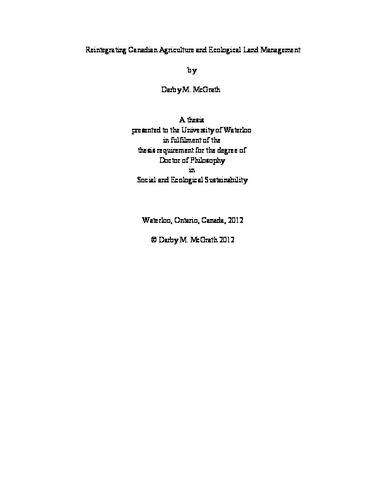| dc.contributor.author | McGrath, Darby M. | |
| dc.date.accessioned | 2012-09-21 21:04:01 (GMT) | |
| dc.date.available | 2012-09-21 21:04:01 (GMT) | |
| dc.date.issued | 2012-09-21T21:04:01Z | |
| dc.date.submitted | 2012 | |
| dc.identifier.uri | http://hdl.handle.net/10012/7011 | |
| dc.description.abstract | There are three distinct motivating factors behind this research: 1) ecosystems are threatened across Canada and require locations within which to establish or re-establish natural features to support native species; 2) agricultural livelihoods for small and medium farmers in Canada are insufficient; 3) there are increasing societal demands on farmers to ascribe to “environmentally friendly” agricultural practices. In Canada there is no comprehensive or integrated agricultural-environmental policy agenda that deals with these interrelated issues. This research explores the interaction of the issues within a cross-scalar framework that explores a relatively new concept, novel ecosystems, in order to provide a targeted approach to agri-environmental programming for the Canadian setting. Market forces and technological changes have driven Canadian agricultural policy and have shaped contemporary agriculture-ecological interactions on farmlands across Canada. The concept of novel ecosystems is expanded to focus on maintaining farm communities and protecting and rehabilitating rural ecosystems and ecosystem services as a response to the drivers of landscape decision-making. The outcome is a framework that integrates the literature pertaining to ecosystem management and transformation and sustainable transitions to guide the usage of novel ecosystems for agricultural programming. A case study in the Niagara Region that examined the program content of different relevant agri-environmental initiatives and engaged the local farming community revealed that landowners would be interested in programs that are based on the principle of maximum net gains (sensu Gibson et al. 2005). In this study, maximum net gains requires designing an agri-environmental program that ensures that, financially, farmers can continue farming while at the same time improving social, cultural, ecological and financial environment in which they are embedded. A pilot case example of the technical implementation of novel agro-ecosystem component using two irrigation ponds and and three species (Scirpus atrovriens, Carex lacustris, and Sagittaria latifolia) and as of 2011 repeated measures ANOVA indicated that singular plantings of S. latifolia at densities of as little as 1 ramet/50 cm2 is an effective strategy in establishing a dominant plant community in semi-naturalized irrigation ponds. However, for restoration of irrigation ponds on agricultural lands devoid of facultative wetland species planting S. atrovirens at densities of 3 ramets/50 cm2 is an effective strategy in establishing a dominant emergent vegetation community. A synthesis demonstrates how the findings interact in reality and forms the basis for a multi-scaled approach for an agroecological policy agenda. This is accomplished using research called Wild LifeLines™ by Fields et al. (2010) and a spatially explicit asset inventory to create an approach that triages agricultural landscapes and determines how to incorporate novel ecosytems into individual farms and particularly, outlines the significance of a cross-scalar approach for agri-environmentalism in Canada. | en |
| dc.language.iso | en | en |
| dc.publisher | University of Waterloo | en |
| dc.subject | agriculture | en |
| dc.subject | ecology | en |
| dc.title | Reintegrating Canadian Agriculture and Ecological Land Management | en |
| dc.type | Doctoral Thesis | en |
| dc.pending | false | en |
| dc.subject.program | Environmental and Resource Studies | en |
| uws-etd.degree.department | Environment and Resource Studies | en |
| uws-etd.degree | Doctor of Philosophy | en |
| uws.typeOfResource | Text | en |
| uws.peerReviewStatus | Unreviewed | en |
| uws.scholarLevel | Graduate | en |

